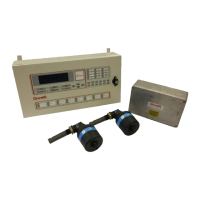6. At the Control Panel disconnect the communications + and connections from the terminals.
7. Using a multi-meter measure voltage between the two wires. The voltage measured should be
between 200 300mV.
If the voltage measured is not between 200 300mV go to 8.
If the voltage measured is between 200 300mV replace the wires into the communications +
and terminals.
8. At the Junction Box measure the voltage across the EOL terminals, TB10. The voltage measured
should be between 200 300mV.
If the voltage measured is not between 200 300mV the Junction Box PCB should be replaced.
9. At the connections to the Control Panel, TB9, measure the voltage between the communications +
and terminals. The voltage measured should be between 200 300mV.
If the voltage measured is not between 200 300mV there may be a break in the detector cable
connections. Measure the voltage between the C+ IN and C- IN terminals of each detector. To
identify the failed connection. In each case the measured voltage should be between 200
300mV.
If the voltage measured is between 200 300mV replace the communications cable between
the Control Panel and Junction Box.
5.2.2.2 Single Detector in fault
In this situation the Control Panel indicates a communication fault on an individual detector on an engine.
When moving detectors, it is recommended that the detectors are first isolated and the detector cable
disconnected before removing the detector head from the base. The detectors should be deisolated after
moving.
1. Swap the detector with a known working detector. It is not necessary to change the detector
addresses.
2. Reset the Control Panel.
3. Wait for the communications fault to be indicated again.
If the fault indication remains at the original position return the swapped detectors to the initial
positions, go to item 4
If the fault indication moves to the new position of the detector, the detector has failed and
should be replaced.
4. Check the connections of the detector cable in the Junction box.
If the connections are correct the detector cable is damaged internally and should be replaced.
If the connections are incorrect, they should be corrected.
5.2.2.3 Consecutive detectors on an engine in fault
In this situation the Control Panel indicates communication faults on a number of consecutive detectors
on an engine.
A daisy chain connection is used for communications between the Junction Box and the detectors.
Communications data is passed from the Junction Box to detector 1, returns to the Junction Box and is
passed to detector 2 etc. A break in the communications path will result in a loss of communications
between the break and subsequent detectors in the chain.

